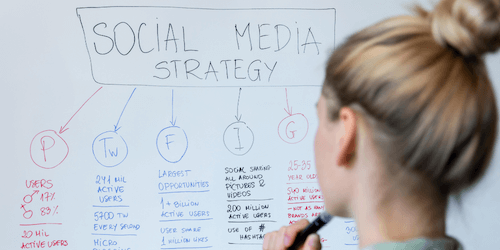Top social media platforms for nonprofits: Where to focus your marketing efforts
So you’re interested in gaining social traction on your mission through social media? We recently wrote on how to build a nonprofit social media marketing plan, but one of the larger factors when developing that plan is picking the right platforms for your audiences.
Today we’re going to break down the top social media platforms for nonprofits that your organization needs to consider making a priority when building out a nonprofit social media marketing plan.
Take it easy
Before we jump into the three platforms (we’ll talk about five others you may want to consider after), we wanted to take a second to remind you that marketing isn’t about perfection. When it comes to content, there isn’t one way of hacking it.
And if your audience is expecting perfect, then maybe they shouldn’t be your friend in the first place…
So take a big breath, and definitely aim for great content. But be yourself, take some risks, and learn from it all. That’s all anyone should expect from anyone else.
Picking the platform
Ok, a few notes before we start talking specific platforms:
First, please don’t think that you need to be active on every social media platform. Though the average person who’s active on social media has 6.7 different accounts, they likely aren’t expecting you to show up in all 6.7 places. That actually could be annoying to follow someone around to all 6.7 spots.
We think expanding your presence on social media is more about where you are today and where you want to go. Consider expanding to a new platform if you’re currently on two or three, and you’re seeing results that are promising.
Second, as there’s a time to add platforms, there’s also a time to drop them. When they aren’t performing how you want or if the people who are engaging with you on those platforms aren’t moving your organization forward, ask yourself the question, “would my time be better spent elsewhere?”
And third, approach the question of platform primarily from the lens of asking where your ideal audience is. There isn’t a single right answer for what platform you should use. The answer is dependent on what your organization is specifically looking for.
So what’s right for one nonprofit may be wrong for yours. Because nonprofit social media marketing is ultimately about relationships, approach it first like an art and make bold strokes. The science part comes in by collecting good first-party data and then making the best decisions you can with it — and sprinkling in some psychology here and there.
1. Facebook
According to a study by the Pew Research Center, 68% of Americans use the platform. This is the clear winner when it comes to the traditional social media platforms.
The only platform that has a larger share of active people is YouTube, which isn’t exactly a pure social media platform (but we’ll still talk about it more at number three).
Facebook and YouTube are unique in capturing a majority of all age groups. So Facebook may be the one clear winner when it comes to knowing if a social platform includes your ideal audiences.
And when it comes to other demographics including race, political affiliation, and household income, Facebook is diverse compared to its peers. The only exception, according to the study, is gender — with 59% of men participating on the platform against 76% of women.
We likely won’t offer many prescriptions for other social media platforms (unless you consider YouTube a social media platform), but Facebook is a good place to start if you aren’t currently posting. And that’s really because it covers most majorities.
And it even offers fundraising tools for nonprofits raising support on the platform. That’s a win-win!
2. Instagram
Instagram is the second most used social platform with 47% of American adults using it regularly. But Instagram is very different when it comes to demographics.
The people on the platform skew heavily toward younger generations with 78% of those between 18 and 29 reporting usage compared to 59% between 30 and 49, 35% between 50 and 64, and only 15% that are 65 or older.
This is a great platform if two things are true about your nonprofit social media strategy: You want to engage with these younger demographics. And, you have the bandwidth and personnel to create captivating imagery.
Unlike Twitter or Facebook where you can lean heavily toward text, Instagram is built around the image or video, putting it front and center. That doesn’t mean that your images or videos have to look like Apple’s or Google’s, but it does mean that to excel on the platform, you’ll need to be comfortable posting in those formats.
But if you need to reach younger audiences, they’re definitely here for the taking!
3. YouTube
Ok, we don’t exactly consider YouTube to be a social media platform, but it often acts like one. And because 83% of Americans use the platform, leveraging this site is well worth the effort.
As you likely know (since there are 83% odds you’re on the platform), it’s all about video here. And that’s a perfect way to show your human side, connecting with your community face to face.
We said it for Instagram, but don’t compare your video quality to Apple’s or Google’s or even your biggest competitor. Just put one foot in front of the other and share your story. People aren’t expecting perfect. They care more about hearing your personal and organizational story.
And because YouTube is owned by Google, you shouldn’t be surprised that they have a generous nonprofit program to help you jump in with both feet.
What about all the others?
We know how intimidating the whole subject of nonprofit social media marketing can be, so we wanted to stick with the major players today. But the rest of the pack do have some unique characteristics, which we’ll quickly highlight if you’re looking for that niche audience.
One thing to note here, while the top three were being used by nearly half of all Americans, the following only get as high as 35%, so note that the percentage next to each platform is the percent of American adults who report using the site (according to the same Pew Research Center study linked above):
Pinterest (35%): About half of women report using the platform while only 19% of men do. So this means that if you’re a nonprofit looking to expand your reach with women, this is a great place to start.
TikTok (33%): This is the fastest growing platform in recent years, so maybe one day it will be in the top three. And you probably already know this, but this is a great choice if you’re looking specifically to engage Gen Z.
LinkedIn (30%): This site is focused entirely around professional networking. And because of that, the site skews toward higher income earners. But most people are here for the job hunt or for personal career growth, so consider how your messaging should meet people’s needs.
Twitter (22%): I still don’t have the stomach to call this X, but maybe that shows my age. This used to be near the top of the list, and the format of short text is fun (at least for me as a writer). But the format doesn’t always lend itself to the deepest of discussions.
WhatsApp (29%): This is an all-in-one messaging and phone app, so it’s very popular for those traveling that don’t want to pay for roaming. Majorities of Hispanic and Asian adults use the platform while only 31% of Black adults and 20% of White adults report activity on the site.
Closing thoughts
Ok, we know we still didn’t cover them all. What about Reddit (22%), Snapchat (27%), and BeReal (3%)? We could have included all those, but then next month we’d probably have to add another two or three more.
Share this
You May Also Like
These Related Stories

How to create a nonprofit social media plan that sticks

Building a nonprofit social media strategy: 5 steps and tips

.png?width=150&height=63&name=Feathr%20Logo-Main%20(1).png)
